Ambitious targets of a 350,000t reduction in nitrogen (N) fertiliser have been targeted by 2025.
Recent figures from the Department of Agriculture show that there was a 14% reduction in N used by farmers in 2022 (343,193t used in 2022 down from 399,164t in 2021), and highlight how farmers have improved N management in the past year and are on target to achieve this reduction.
Some of this reduction can be accounted to the higher price of retailed chemical N.
There has been a growing awareness of the importance of legumes, in particular white clover integration into grassland systems, and the reduction in N that accompanies the incorporation of clover.
The Clover 150 pilot farm project was established in 2021 by the grassland science department in Teagasc and has 35 farms across the country enrolled in the programme.
The project will run from 2021 to 2026 on farms across a variety of enterprises, land types and geographic spread.
There are four objectives of the programme.
Reduce N surplus of <130kg N/ha and an increase N use efficiency >40% on each individual farm.Use 150kg N fertiliser per hectare per year or less. Increase the average sward clover proportion to between 20% and 25% on the farm.Grow 14t DM/ha on each farm.In 2022, analysis was carried out on a matched sample of 16 dairy farms in the project between 2020 and 2022.
In 2020, the Clover 150 pilot farms had <10% average clover area over the entire milking platform. By April 2022, the average clover area had increased to 45%.
Within 2022, the land area under clover had increased by 19% to an average clover area of 64% in October of this year. This clover increase arose from a combination of April/May reseeding and April oversowing, with approximately 15% to 20% of the milking platform oversown.
The main lesson learned from the previous year is that oversowing must take place early in the year to make a successful establishment (late March on some farms), while there is still adequate soil moisture.
Oversowing has proved to be a successful method for the rapid clover establishment on these farms. The group follows very clear grazing management guidelines post oversowing, which has contributed to the establishment success.
What impact did increasing clover area have on the Clover 150 farms?
When PastureBase Ireland (PBI) data for the past three years on the matched set of farmers was examined, chemical N fertiliser use in 2020 was 232kg N/ha, with 14.4t DM/ha grown. In 2021, chemical N used declined by 20kg N/ha with an average of 14.1t DM/ha grown. From 2021 to 2022 chemical N reduced by 46kg N/ha. Year to date (mid-November) grass growth will be 13.3t DM/ha, despite a considerable summer drought on the majority of farms this year. The area of the farm under clover accounted for the largest reduction in N fertiliser, as the area of clover increased total N fertiliser reduced (r2 = 34%; Figure 1).
What is an
appropriate clover balance?
The clover proportion varied dramatically between paddocks on Clover 150 pilot farms (from 0 to 70%) with an average clover proportion of 16% on paddocks across 2022. The main objective of the projects is for the participating farms to strike the correct balance between grass and clover on their farms.
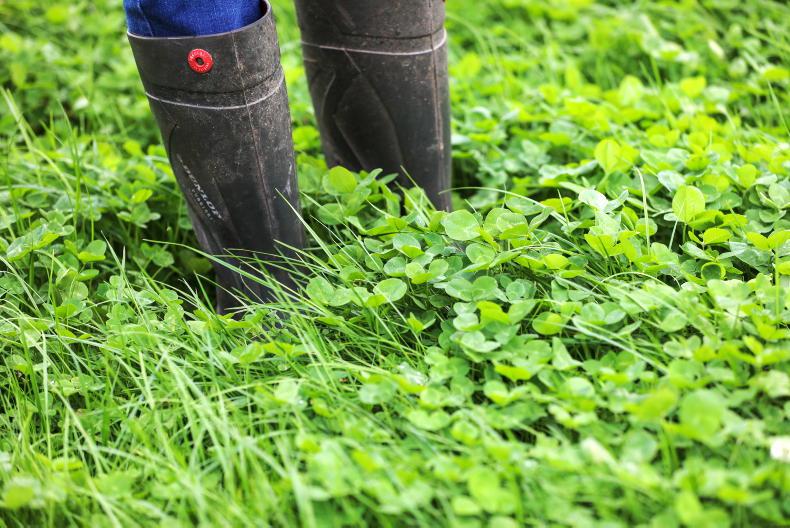
High clover paddocks need to be carefully managed to maintain clover content. \ Odhran Ducie
The target clover proportion on the Clover 150 pilot farms is 20% to 25% across the year, with a minimum proportion of 10% to 15% in spring and a maximum proportion of 40% in autumn. Although some pilot farmers experienced clover proportions greater than 40%, the main challenge is to increase the proportion from single figures to the mid-20s across most of the farm.
The bulk of the effort involves lifting paddocks with low or zero clover content upwards using over-sowing.
Excessively high clover content paddocks can bring an increased risk of bloat. Oversowing has been increased in 2022, to get more paddocks on the farms with better levels of clover.
All farms are aware of management aspects that can increase bloat risk, ie over allocation of high clover paddocks, especially if cows are underfed on their previous grazing, high N release post-drought and extremely low grass DMs.
In general, there is good feedback on the experience in managing grass/clover swards, and as the awareness with the associated risk of bloat, farmers are adjusting their management practices.
Making nitrogen application more precise
Nitrogen planner
One of the major findings from the group this year has been the requirement to have a pre-planned paddock N application plan in place.
Regardless of clover area on the farm, farmers should take the opportunity to plan fertiliser application on each paddock for the 2023 grass year.
The farmers who have previously completed this have shown excellent results this year, with savings on chemical N and better use of slurry and soiled water.
The N planner in PastureBase Ireland allows farmers to track individual paddock requirements (grazing/silage and clover/non-clover) and tailors chemical and organic fertiliser application to each paddock. This allows farmers to forward plan chemical fertiliser and removes the temptation to apply excess chemical fertiliser throughout the season.
Using soiled water
as a valuable source
of nutrients
Soiled water on the farm cannot be underestimated and it should utilised for all swards, but particularly high-clover swards.
Clover 150 farmers found that approximately 2,000 gallons of soiled water successfully replaced chemical N in summer rotations on established clover swards (> 25% clover; half a rate of N – 9kg N/ha).
On average across the country, 1,000 gallons of soiled water equates to three to four units N, 0.7 units P, 5 units K.
Dairy soiled water provides a source of N, as well as P and K for swards which is a vital element to maintain and increase clover DM production and persistence.
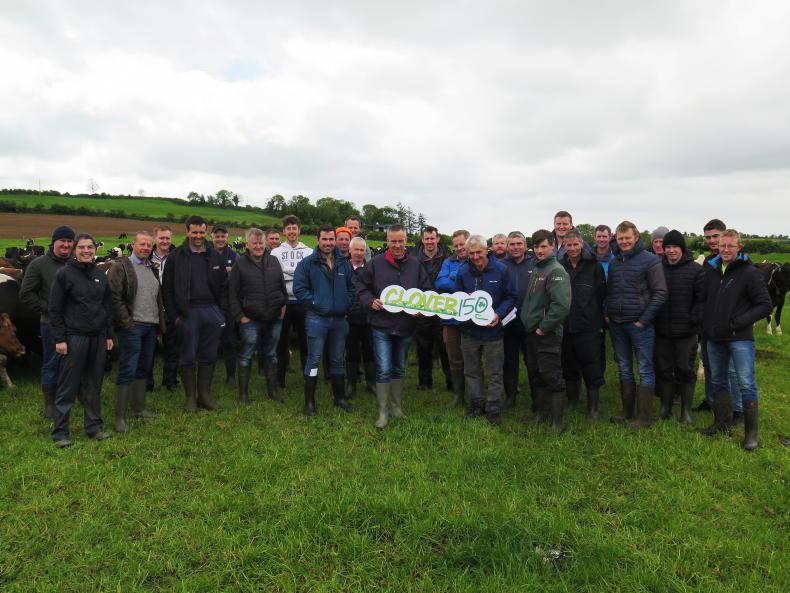
Members of the Clover 150 group with Teagasc researchers Michael O'Donovan, Mike Egan and Caitlin Looney.
Efficient N management on farms takes forward planning at a paddock level. The use of the N planner in PastureBase Ireland provides farmers with a tool to identify and tailor N applications for the grazing year.
Clover will be the main innovation responsible for a rapid reduction in chemical N, as seen on the Clover 150 pilot farms.
Increasing clover content on farms can be successfully achieved if oversowing takes place in late March/April. However, grazing management in the first year is critical to establish sufficient levels of clover (follow the establishment blueprint).
Farmers need to be mindful and maintain clover levels at an average of 25% clover content throughout the grazing season to ensure a balance of grass and clover in paddocks, so that both species can work together in the production of high-quality grass.
Chemical N use reduced by 66kg N/ha (28%) on the Clover 150 pilot farms between 2020 and 2022. The clover area increased by 19% from spring to autumn in 2022, with 64% of the farm area in clover in October 2022.Grass DM production reduced by approximately 1.1t DM/ha between 2020 and 2022.Clover was established with a combination of reseeding and over-sowing, with double the area over-sown. PastureBase nitrogen planners will be implemented by farmers for 2023 to better manage and supply N.
Ambitious targets of a 350,000t reduction in nitrogen (N) fertiliser have been targeted by 2025.
Recent figures from the Department of Agriculture show that there was a 14% reduction in N used by farmers in 2022 (343,193t used in 2022 down from 399,164t in 2021), and highlight how farmers have improved N management in the past year and are on target to achieve this reduction.
Some of this reduction can be accounted to the higher price of retailed chemical N.
There has been a growing awareness of the importance of legumes, in particular white clover integration into grassland systems, and the reduction in N that accompanies the incorporation of clover.
The Clover 150 pilot farm project was established in 2021 by the grassland science department in Teagasc and has 35 farms across the country enrolled in the programme.
The project will run from 2021 to 2026 on farms across a variety of enterprises, land types and geographic spread.
There are four objectives of the programme.
Reduce N surplus of <130kg N/ha and an increase N use efficiency >40% on each individual farm.Use 150kg N fertiliser per hectare per year or less. Increase the average sward clover proportion to between 20% and 25% on the farm.Grow 14t DM/ha on each farm.In 2022, analysis was carried out on a matched sample of 16 dairy farms in the project between 2020 and 2022.
In 2020, the Clover 150 pilot farms had <10% average clover area over the entire milking platform. By April 2022, the average clover area had increased to 45%.
Within 2022, the land area under clover had increased by 19% to an average clover area of 64% in October of this year. This clover increase arose from a combination of April/May reseeding and April oversowing, with approximately 15% to 20% of the milking platform oversown.
The main lesson learned from the previous year is that oversowing must take place early in the year to make a successful establishment (late March on some farms), while there is still adequate soil moisture.
Oversowing has proved to be a successful method for the rapid clover establishment on these farms. The group follows very clear grazing management guidelines post oversowing, which has contributed to the establishment success.
What impact did increasing clover area have on the Clover 150 farms?
When PastureBase Ireland (PBI) data for the past three years on the matched set of farmers was examined, chemical N fertiliser use in 2020 was 232kg N/ha, with 14.4t DM/ha grown. In 2021, chemical N used declined by 20kg N/ha with an average of 14.1t DM/ha grown. From 2021 to 2022 chemical N reduced by 46kg N/ha. Year to date (mid-November) grass growth will be 13.3t DM/ha, despite a considerable summer drought on the majority of farms this year. The area of the farm under clover accounted for the largest reduction in N fertiliser, as the area of clover increased total N fertiliser reduced (r2 = 34%; Figure 1).
What is an
appropriate clover balance?
The clover proportion varied dramatically between paddocks on Clover 150 pilot farms (from 0 to 70%) with an average clover proportion of 16% on paddocks across 2022. The main objective of the projects is for the participating farms to strike the correct balance between grass and clover on their farms.

High clover paddocks need to be carefully managed to maintain clover content. \ Odhran Ducie
The target clover proportion on the Clover 150 pilot farms is 20% to 25% across the year, with a minimum proportion of 10% to 15% in spring and a maximum proportion of 40% in autumn. Although some pilot farmers experienced clover proportions greater than 40%, the main challenge is to increase the proportion from single figures to the mid-20s across most of the farm.
The bulk of the effort involves lifting paddocks with low or zero clover content upwards using over-sowing.
Excessively high clover content paddocks can bring an increased risk of bloat. Oversowing has been increased in 2022, to get more paddocks on the farms with better levels of clover.
All farms are aware of management aspects that can increase bloat risk, ie over allocation of high clover paddocks, especially if cows are underfed on their previous grazing, high N release post-drought and extremely low grass DMs.
In general, there is good feedback on the experience in managing grass/clover swards, and as the awareness with the associated risk of bloat, farmers are adjusting their management practices.
Making nitrogen application more precise
Nitrogen planner
One of the major findings from the group this year has been the requirement to have a pre-planned paddock N application plan in place.
Regardless of clover area on the farm, farmers should take the opportunity to plan fertiliser application on each paddock for the 2023 grass year.
The farmers who have previously completed this have shown excellent results this year, with savings on chemical N and better use of slurry and soiled water.
The N planner in PastureBase Ireland allows farmers to track individual paddock requirements (grazing/silage and clover/non-clover) and tailors chemical and organic fertiliser application to each paddock. This allows farmers to forward plan chemical fertiliser and removes the temptation to apply excess chemical fertiliser throughout the season.
Using soiled water
as a valuable source
of nutrients
Soiled water on the farm cannot be underestimated and it should utilised for all swards, but particularly high-clover swards.
Clover 150 farmers found that approximately 2,000 gallons of soiled water successfully replaced chemical N in summer rotations on established clover swards (> 25% clover; half a rate of N – 9kg N/ha).
On average across the country, 1,000 gallons of soiled water equates to three to four units N, 0.7 units P, 5 units K.
Dairy soiled water provides a source of N, as well as P and K for swards which is a vital element to maintain and increase clover DM production and persistence.

Members of the Clover 150 group with Teagasc researchers Michael O'Donovan, Mike Egan and Caitlin Looney.
Efficient N management on farms takes forward planning at a paddock level. The use of the N planner in PastureBase Ireland provides farmers with a tool to identify and tailor N applications for the grazing year.
Clover will be the main innovation responsible for a rapid reduction in chemical N, as seen on the Clover 150 pilot farms.
Increasing clover content on farms can be successfully achieved if oversowing takes place in late March/April. However, grazing management in the first year is critical to establish sufficient levels of clover (follow the establishment blueprint).
Farmers need to be mindful and maintain clover levels at an average of 25% clover content throughout the grazing season to ensure a balance of grass and clover in paddocks, so that both species can work together in the production of high-quality grass.
Chemical N use reduced by 66kg N/ha (28%) on the Clover 150 pilot farms between 2020 and 2022. The clover area increased by 19% from spring to autumn in 2022, with 64% of the farm area in clover in October 2022.Grass DM production reduced by approximately 1.1t DM/ha between 2020 and 2022.Clover was established with a combination of reseeding and over-sowing, with double the area over-sown. PastureBase nitrogen planners will be implemented by farmers for 2023 to better manage and supply N. 






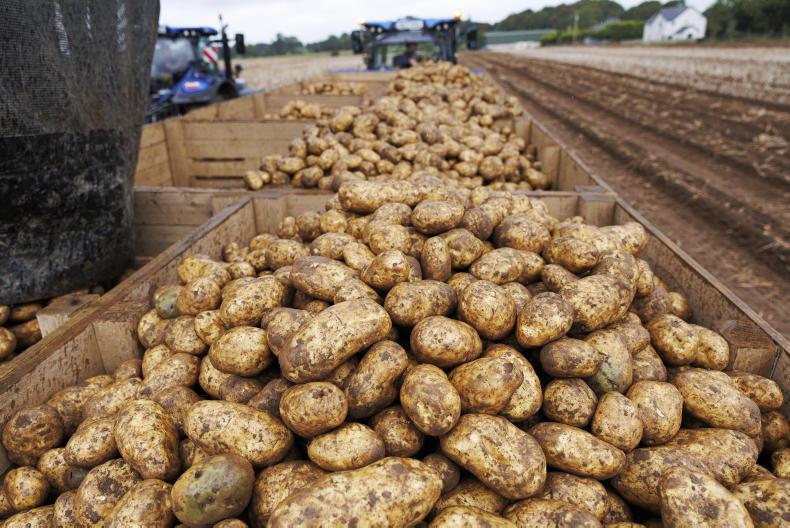
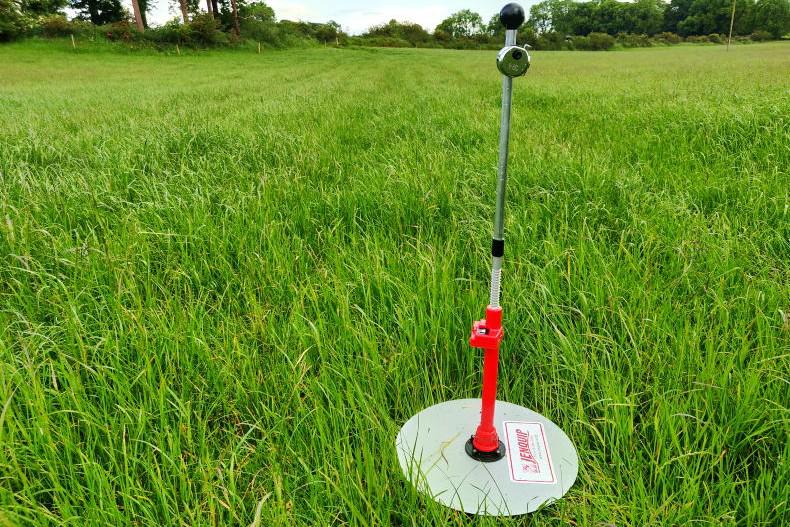
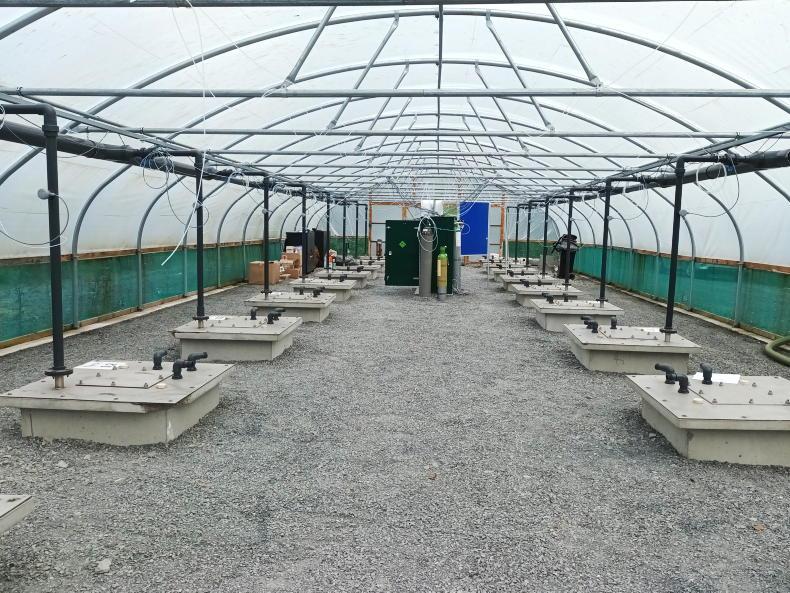

SHARING OPTIONS